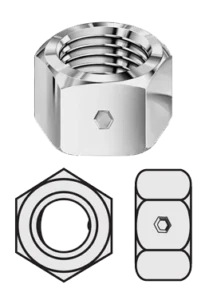HEX-LOC®
Reversible Prevailing-Torque Locknut
The HEX-LOC® is an all-metal fastener engineered to provide a reliable and reusable locking mechanism in various applications. This locknut’s design incorporates deflected threads at the center of the nut, creating frictional interference that ensures a secure, two-way locking action.
HEX-LOC® locknuts are designed to maintain joint integrity under conditions involving continuous heavy vibration, shock, extreme temperatures, and numerous loading cycles. The central deflected threads produce a prevailing torque that resists loosening without the need for additional locking devices. This self-locking feature is crucial in applications where maintaining consistent clamping force is essential for safety and performance.
Application
HEX-LOC® locknuts are suitable for a wide range of applications, including:
- Automotive Industry: Securing components subject to constant vibration and dynamic loads.
- Machinery and Equipment: Maintaining the integrity of assemblies in industrial machines operating under harsh conditions.
- Aerospace Sector: Providing reliable fastening solutions in environments with extreme temperatures and mechanical stresses.
Specifications
Sizes
Available in various sizes, including special light or heavy torque versions, to accommodate different application requirements.
Materials
Manufactured from steel grades 2, 5, and 8, Monel, brass, bronze, stainless steel, and a selection of exotic metals to suit different environmental conditions and strength needs.
Threads
Offered in American Standard and Metric, including hex-finished, jam, heavy, hi, square, acorn, weld, track, and flange nuts, to accommodate diverse threading standards.
Finishes
Options include plain, zinc, and cadmium, as well as other platings and coatings to meet specific corrosion resistance needs.
Installation
The installation process for the HEX-LOC® locknut is straightforward:
Threading
Manually spin the locknut onto the bolt until it contacts the bearing surface.
Seating
Continue to tighten the locknut using an appropriate wrench until it is firmly seated against the base.
Locking
As the nut is tightened, the central deflected threads create frictional interference, producing a prevailing torque that secures the nut in place.
This method ensures a secure and maintenance-free fastening without the need for supplementary locking devices.

